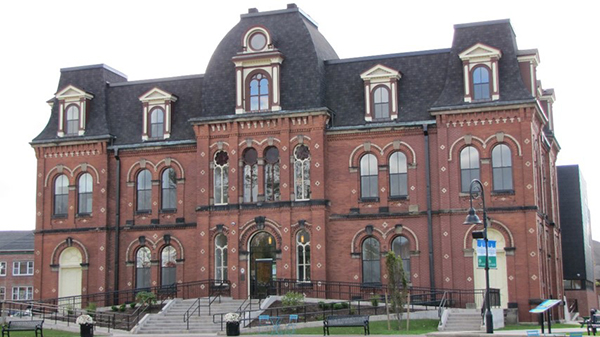Truro Old Normal College National Historic Site

© C. Boucher, Parks Canada, 2017
Truro Old Normal College was designated a national historic site in 2021.
Commemorative plaque: no plaque installedFootnote 1
Truro Old Normal College, Truro, Nova Scotia
A major landmark in downtown Truro, this impressive, three-storey brick building is an excellent example of Second Empire architecture. Designed by Nova Scotia architect Henry Frederick Busch, it features a mansard roof, a well-proportioned central pavilion, pedimented gable dormers, ornate brackets under its pronounced eaves, and arched windows. Built in 1877 to replace the first normal school in Truro, it was used as a normal college until 1961. It is a testament to the movement in the second half of the 19th century to standardize and improve teacher training, and it is directly associated with the development of Nova Scotia’s public education system in the 19th and 20th centuries.
Truro Old Normal College is located in downtown Truro (752 Prince Street), a town in central Nova Scotia less than 100 km northeast of Halifax. As a “normal school,” its function was the training of teachers. It was built by the provincial department of education to replace Truro’s first normal school, an institution that had been established in 1855 but became too small by the 1870s. The Truro normal schools were established during a time of dramatic change in education in British North America. Over the decades between 1840 and 1870, governments committed unprecedented resources to the construction and regulation of schools and put in place legislation regarding schooling. This included the standardization and certification of teacher training. Truro Old Normal College was used to train teachers until 1961, and for many years it was the only college of its type in the province. After the college closed, the building became the Truro YMCA and, later, temporarily housed the town’s municipal offices.
The Old Normal College is a very fine example of Second Empire architecture. This imposing three-storey brick building has a raised basement and a symmetrical, T shaped layout. Its exterior cladding is red brick and contains contrasting geometric motifs in white brick, which contributes to the building’s uniqueness and is characteristic of the work of its designer, architect Henry Frederick Busch. The front façade is strongly symmetrical and features a central entry as well as two side doors. The building also has many windows, which flood its interior with natural light.
A recommendation to restore the old normal college was part of a 2006 redevelopment plan for the block. As a result, the building has been renovated and expanded with the addition of a contemporary annex to accommodate the Truro branch of the Colchester–East Hants Public Library. The recent rehabilitation work has preserved the key architectural characteristics of the building’s exterior, while the interior has been completely renovated to meet the current needs of the new municipal library. Nevertheless, some of the building’s significant features have been highlighted, such as the stained glass windows, some of the original windows, and certain mouldings. Completed in May 2016, the new library and the redevelopment of the adjacent gardens helped the building regain its former visibility and once again made it a landmark in downtown Truro.
Backgrounder last update: 2021-06-01
Description of historic place
Truro Old Normal College National Historic Site of Canada is located in the heart of downtown Truro, a town in central Nova Scotia less than 100 km northeast of Halifax. Clad in red brick with contrasting geometric motifs in white brick, this imposing three-storey building with a raised basement has a T-shaped layout. The building’s symmetrical façade features a central entrance and two side entrances. Official recognition refers to the building on its lot at the time of designation.
Heritage value
Truro Old Normal College was designated a national historic site of Canada in 2018. It is recognized because:
- as a major landmark in downtown Truro, this impressive, three-storey brick building designed by Nova Scotia architect Henry Frederick Busch is an excellent example of Second Empire architecture, with its mansard roof, well-proportioned central pavilion, its pedimented gable dormers, the ornate brackets under its pronounced eaves and its arched windows;
- built in 1877 to replace the first normal school in Truro, it was used as a normal college until 1961. It is a testament to the movement in the second half of the 19th century to standardize and improve teacher training in Canada, and it is directly associated with the development of Nova Scotia’s public education system in the 19th and 20th centuries.
The former Truro College was built in 1877 by the provincial department of education to replace the original Truro normal school, which had been established in 1855 but had become too small by the 1870s. The building is linked to the history and development of Nova Scotia’s public education system because it served as a teacher training facility until its closure in 1961, being the only school of its kind in the province for many years.
After the college closed, the building became the Truro YMCA and, later, temporarily housed Truro’s municipal offices. Following its rehabilitation and the construction of an addition in 2016, the former school reopened as a public library. The original building was a perfect example of Second Empire architecture and, even after the rehabilitation work, it has preserved its key exterior features. While the interior was completely renovated to meet the needs of the new library, significant features were highlighted such as stained glass windows and some of the original windows and mouldings. Today, it is a landmark in Truro’s town square.
Source: Historic Sites and Monuments Board of Canada, Minutes, December 2017.
The National Program of Historical Commemoration relies on the participation of Canadians in the identification of places, events and persons of national historic significance. Any member of the public can nominate a topic for consideration by the Historic Sites and Monuments Board of Canada.
- Date modified :